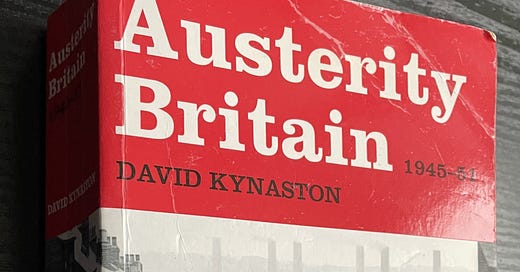This enormously thick book had been on my To Read pile for well over a year when I finally got round to it at the start of January. It’s from 2007 and is the first of four volumes by David Kynaston dealing with Britain in the period 1945-79, which are collectively known as Tales of a New Jerusalem.
I would say that it pays to know the general events of the time before you dive in. The 1945-51 Labour government was my favourite bit of GCSE History and in the intervening 30 years I’ve read books and articles about the creation of the NHS, nationalisation, the earlier foundations of the post-war welfare state in English poor law etc, education in England and its provision to working class pupils1. In short, I was looking to this book to give me detail, and I got it in spades.
Kynaston makes extensive use of Mass Observation documents and private diaries, which are excellent for giving a real flavour of the times. Rather than the broader sweep of history you get eyewitness accounts of how that impacted day to day life, what people’s real concerns were and how much of The News they noticed, and how complicated and mixed up personal politics (as opposed to party politics) tends to be.
If you’re interested in the period because you don’t know much about it and would like to find out what went on, I don’t think this is the book to start with. It’s broadly chronological but there are so many asides as we look at what this meant for the several diarists2 that recur, that it’s very easy to lose the thread of what month we’re in and what’s just happened. I’m also not sure he always explains what the significance of an event or a policy is.
That said, by the end I felt like I’d been immersed in ordinary life (similar to when I’d read Ian Mortimer’s Time Traveller’s Guides to Medieval and Elizabethan England). I deepened my understanding of the context of Labour’s post-war compromises, and also gained an insight into the hardships of my Nana’s early married life which I got glimpses of through her anecdotes when I was a child. I enjoyed the book, though it took me about six weeks to read, and I recommend it for anyone else who’s looking for behind the scenes detail from the period.
Of course, my reading this volume prompted my dad to delve into volume 2, Family Britain 1951-59, which has been waiting on his shelf all along. Expect to see that in my ‘what I plan to read next year’ photo for 2026. And maybe also 2027.
I even wrote for Edinburgh University’s Dangerous Women Project about evening classes for working women in Bradford: https://dangerouswomenproject.org/2016/08/17/bradford-female-educational-institute/
One of whom is Nella Last, who you may know as the main character in Victoria Wood’s Housewife, 49




